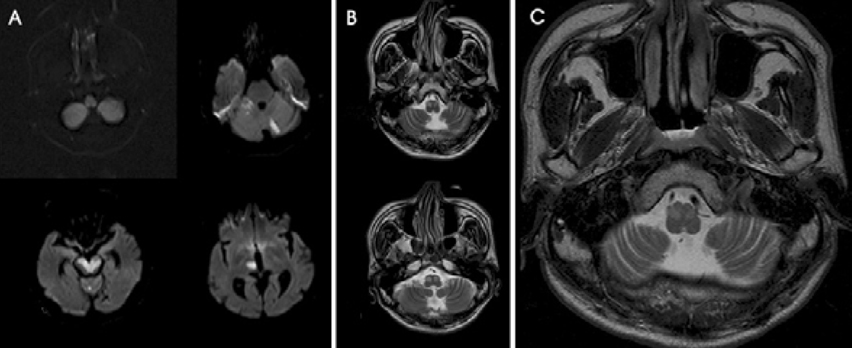J Clin Neurol.
2006 Sep;2(3):206-208. 10.3988/jcn.2006.2.3.206.
Delayed-Onset Continuous Bruxism with Olivary Hypertrophy After Top of the Basilar Syndrome
- Affiliations
-
- 1Department of Neurology, Hallym University College of Medicine, Seoul, Korea. yangki2@unitel.co.kr
- KMID: 2287696
- DOI: http://doi.org/10.3988/jcn.2006.2.3.206
Abstract
- Delayed-onset continuous bruxism due to brain stem infarction has not yet been reported. A 49-year old man presented with quadriplegia and ophthalmoplegia. Brain MRI showed acute infarction in the bilateral midbrain, right thalamus and the superior cerebellum. One month later, the patient developed bruxism which persisted during sleep. A palatal myoclonus was not observed. Follow up MRI taken 4 months later showed bilateral olivary hypertrophy. We suggest that the patient's bruxism may be related to the olivary hypertrophy. The bruxism generator may be located in the pontine-reticular-formation (PRF). Bilateral large midbrain lesions interrupting the cortical inhibition may have produced bilateral olivary hypertrophy, which could stimulate the PRF, producing continuous bruxism.
MeSH Terms
Figure
Reference
-
1. Bader G, Lavigne G. Sleep bruxism; an overview of an oromandibular sleep movement disorder. Sleep Med Rev. 2000. 4:27–43.
Article2. Tan EK, Chan LL, Chang HM. Severe bruxism following basal ganglia infarction: insights into pathophysiology. J Neurol Sci. 2004. 217:229–232.
Article3. See SJ, Tan EK. Severe amphetamine-induced bruxism: treatment with botulism toxin. Acta Neurol Scand. 2003. 107:161–163.4. Wali GM. Asymmetrical awake bruxism associated with multiple systemic atrophy. Mov Disord. 2004. 19:352–355.5. Nakamura Y, Katakura N. Generation of masticatory rhythm in the brain tem. Neurosci Res. 1995. 23:1–19.6. Fay RA, Norgren R. Identification of rat brainstem multisynaptic connections to the oral motor nuclei using pseudorabies virus. I: masticatory muscle motor system. Brain Res Rev. 1997. 25:255–275.
Article7. Nishie M, Yoshida Y, Hirata Y, Matsunaga M. Generation of symptomatic palatal tremor is not correlated with inferior olivary hypertrophy. Brain. 2002. 125:1348–1357.
Article8. Chandler SH, Goldberg LJ. Effects of pontomedullary reticular formation stimulation on the neuronal responsible for rhythmical jaw movements in the guinea pig. J Neurophysiol. 1988. 59:819–832.
Article9. Pollack IA, Cwik V. Bruxism following cerebellar hemorrhage. Neurology. 1989. 39:1262.
Article10. Partab-Chard R, Gourie-Devi M. Bruxism: its significance in coma. Clin Neurol Neurosurg. 1985. 87:113–117.
Article
- Full Text Links
- Actions
-
Cited
- CITED
-
- Close
- Share
- Similar articles
-
- Horizontal Ocular Tremor after Pontine Hemorrhage with Delayed Olivary Hypertrophy
- Differences in Psychological Changes after Botulinum Toxin A Administration for Bruxism with Masseter Hypertrophy
- "Top of the basilar" Syndrome with the Occlusion Of Left Subclavian Artery
- A Case Report of the "Top of the Basilar" Syndrome with Peduncular Hallucinosis
- Bilateral Hypertrophic Olivary Degeneration in Wilson Disease


